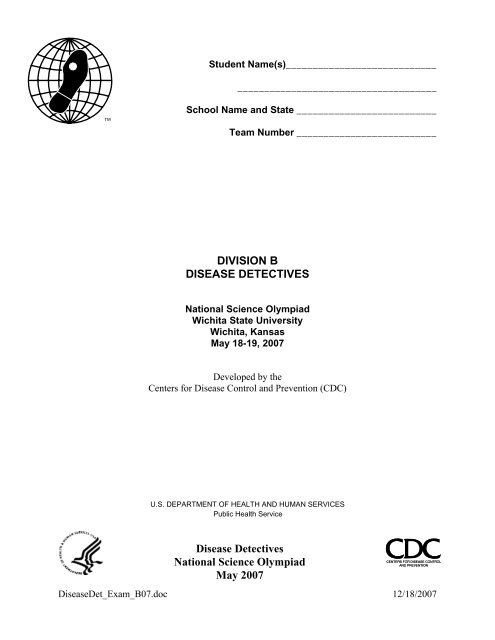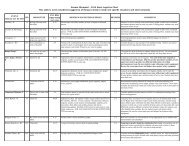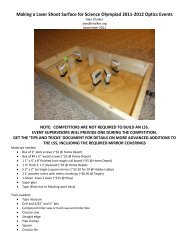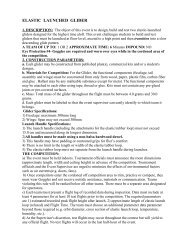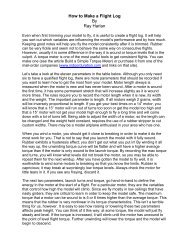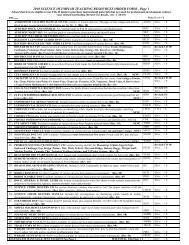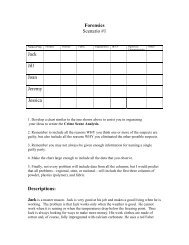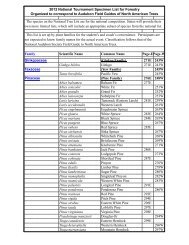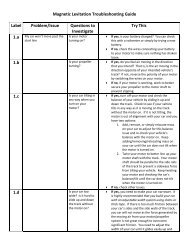DIVISION B DISEASE DETECTIVES Disease ... - Science Olympiad
DIVISION B DISEASE DETECTIVES Disease ... - Science Olympiad
DIVISION B DISEASE DETECTIVES Disease ... - Science Olympiad
You also want an ePaper? Increase the reach of your titles
YUMPU automatically turns print PDFs into web optimized ePapers that Google loves.
Student Name(s)_________________________________________________________________School Name and State __________________________Team Number __________________________<strong>DIVISION</strong> B<strong>DISEASE</strong> <strong>DETECTIVES</strong>National <strong>Science</strong> <strong>Olympiad</strong>Wichita State UniversityWichita, KansasMay 18-19, 2007Developed by theCenters for <strong>Disease</strong> Control and Prevention (CDC)U.S. DEPARTMENT OF HEALTH AND HUMAN SERVICESPublic Health Service<strong>Disease</strong> DetectivesNational <strong>Science</strong> <strong>Olympiad</strong>May 2007<strong>Disease</strong>Det_Exam_B07.doc 12/18/2007
This event includes 3 Problems;Problem I: <strong>DISEASE</strong> <strong>DETECTIVES</strong> TACKLE ENVIRONMENTAL HEALTHTotal Suggested time = 10 minutesPublic perceptions of environmental health often are only that it relates to illnesses due to chemicalexposures from pollution. This is only a small part of the environmental disease detectives’ role.Environmental health is the promotion of health and quality of life by preventing or controlling diseasesthat result from interactions between people and their environment. Almost every disease could beconsidered to be caused by either environmental factors or genetic factors. <strong>Disease</strong> detectives considerenvironment very broadly. The human environment is the air we breathe, the water we drink, the food weeat, the climate surrounding us, and the space we live in.1. (2 pts) The environment is one component of a famous triad in epidemiology. List the other twocomponents of that triad.• Agent• Host2. (2 pts) Individual characteristics of people, such as age, may modify the effects of environmentalexposures. List 2 of these that disease detectives need to think of in planning investigations.Answers will vary but may include• Genetic (genes)• Diet (nutrition)• Gender• Physical Condition• Other diseases (Underlying diseases)Environmental epidemiology studies often deal with specific factors which can be measured quantitativelyas either an exposure or a dose. When the factor is a chemical, exposure can be estimated and dosedetermined by measuring the chemical in blood or tissue. For many environmental factors there may be arange of effects from subtle biochemical changes to severe illness3. (1 pt) What is this relationship between dose and severity of illness called?• Dose ResponseThis relationship is important in environmental epidemiology because it can provide a foundation forsafety standards that state or federal government officials can be used to decide which health effects shouldbe prevented.4. (1 pt) Name a U.S. government agency that might use environmental epidemiology to set air orwater quality standards?• Environmental Protection Agency (EPA or USEPA)<strong>Disease</strong>Det_Exam_B07.doc 212/18/2007
Public environmental health problems usually are of two types: they come to our attention becauseconcerns about illnesses, or they arise from potential exposure situations. Procedures to evaluateenvironmentally caused diseases follow the same basic principles as used in communicable disease studies.Some diseases caused by micro-organisms such as bacteria or viruses can also be consideredenvironmentally related diseases.5. (3 pts) Name 3 routes of entry into a person’s body for environmental micro-organisms orchemicals .• Respiratory (breathing or through the air)• Ingestion (food, eating, water or drinking)• Dermal Contact (skin or skin absorption6. (3 pts) Environmental factors that can cause disease could be biological, chemical, or physical.List one of each type. (No credit if you list agents discussed in today’s event)Answers will vary but may includeBiological:• Bacteria or parasites or viruses (Specific genus/species of specific organism or virusname is acceptableChemical:• Drugs• Dust• Skin irritants• Food additives• Food contaminants• Hazardous waste• Toxic waste• PollutionPhysical:• Noise• Climate• Weather• Light• Radiation (Soar, ionizing, ultraviolet, nuclear<strong>Disease</strong>Det_Exam_B07.doc 312/18/2007
Problem II. <strong>DISEASE</strong> <strong>DETECTIVES</strong> TAKE ON A BUDDING PROBLEMTotal Suggested time = 25 minutesLegionnaires’ disease is a severe respiratory infection caused by bacteria belonging to the genusLegionella. It was first described and the causative agent first identified in conjunction with a outbreakassociated with an American Legion convention in Philadelphia, Pennsylvania in 1976. The bacteria iscommonly found in lakes, streams and water supplies and infection results from exposure and inhalation ofaerosols of contaminated water. The illness is commonly diagnosed by isolation or demonstration of thebacteria or bacterial antigens using indirect immunofluorescent assay (IFA) or radioimmunoassay (RIA) orby demonstrating a fourfold or greater rise in specific antibody in paired serum specimens. The followingreport deals with an investigation of an outbreak of Legionnaires disease associated with a flower show inthe Netherlands in 1999.The West Frisian Flower show took place on February 19 to 28, 1999 in Bovenkarspel, Netherlands andattracted 77,061 visitors. From March 7 to 11, 10 persons with severe pneumonia were admitted to a localhospital in nearby Hoorn. Six of eight persons tested had urine antigen tests positive for Legionella.. Anadditional 4 probable cases were identified. Interviews with cases and a group of 21 controls indicatedthat 10 of 10 cases and 4 of the controls had all visited the West Frisian Flower Show.1. (1 pt) What name is used for this type of study design?• Case-control study2. (2 pts) Calculate the relative risk or odds ratio (whichever is most appropriate for this studydesign) for the association between illness and attendance at the show. Show your work in the<strong>Disease</strong>Det_Exam_B07.doc 412/18/2007
space below. (Since 1 cell of your table is zero, add 0.5 to each cell for your final calculationof association)2 x 2 Table10.5 4.50.5 17.5• Odds Ratio = (10.5 * 17.7)/(4.5 * 5) = 81.6Note:• 1pt for correct formula• 1pt for correct answer• No points will be awarded for calculating the relative risk3. Using the above information, write set of case definitions for confirmed and suspect cases (1definition for each) that could be used for further investigations of this outbreak.Confirmed (3 pts ):• Person: Individuals who attended or worked at West Frisian Flower Show withpneumonia or severe respiratory illness and isolation of bacteria or demonstration of Agby IFA or RIA or four-fold increase in antibodies• Place: Bovenkarspel, Netherlands• Time: February 19-28, 1999Suspect (3 pts):• Person: Individuals who attended or worked at West Frisian Flower Show withpneumonia or severe respiratory illness• Place: Bovenkarspel, Netherlands• Time: February 19-28, 1999All local hospitals and health services in the Netherlands were contacted and asked to report cases ofpneumonia among persons who had attended the flower short.4. (2 pts) List two groups of cases who are likely to be missed by the above reporting system.Answers will vary but may include:• Persons who became ill outside the country• Persons who became ill but did not seek medical attention• Persons who became ill but either did not become ill or developed non-respiratoryillnessA number of environmental assessments were undertaken. These included generating maps of the water<strong>Disease</strong>Det_Exam_B07.doc 512/18/2007
system at the flower show site and interviewing exhibitors to identify all water-using products (e.g.fountains, pools, whirlpools, hot tubs, spas, etc) displayed at the exhibition site. An 8-pt risk assessmentscale was used to assignment a risk score to each of the latter products. Two weeks after the end of theflower show, water and swab samples were collected from all potential sources of Legionella on the site.Inquiries indicated that many of the water-using devices were not adequately maintained with respect toroutine disintection. Samples from the municipal water supply were negative for Legionella. However,the organism was cultured from paper filters from a whirlpool spa in Hall 3, a whirlpool spa in Hall 4 and asprinkler installation in another hall (hall 8)5. (1 pt) With respect to the timing of sample collection, what assumption is being made aboutthe water system?• The conditions of the water system at the time of the samples were collected reflect thecondition during the flower show (or no changes were made to the water system betweenthe flower show and the collection of the samples)6. (2 pts) How does this influence the interpretation of both positive and negative test results?• If bacteria were found the samples you are assuming the bacteria were present duringthe flower show• If bacteria were not found in the samples, bacteria may not have been present during theflower show or conditions changed between the flower show and the collection of samplesNote: Both responses are needed for full creditThere were 133 confirmed and 55 probable cases were reported in visitors (178) and exhibitors (10).Dates of onset in these cases ranged from February 25 to March 16. 163 of these persons werehospitalized and 17 confirmed and 4 probable cases died.7. (2 pts) Assuming that exposure took place during the exhibition, give the range of incubationperiods for these cases. (NOTE: In 1999, February had 28 days)Shortest Incubation Period = last date of possible exposure – first date of disease onset =February 25 – February 28 =
exhibitors to complete a survey regarding their health status before and after the exhibition and to havepaired blood specimens collected. These were tested for IgM and IgG antibody levels. The levels of IgMand, to some extent, IgG indicate infection with or exposure to Legionella. The exhibition halls weredivided into 63 cm 2 grids and the geometric mean levels of IgG and IgM determined for the 35 persons inor closest to each grid. The results are shown in Figure 1.Figure. 1. Smoothed mean geometric immunoglobulin (Ig) M antibody titers to Legionella pneumophila of nearest35 exhibitors in hall 3 and 4 per 63 cm2 of exhibition area; confirmed and probable cases among exhibitors in halls 3and 4. • = confirmed case in exhibitor; ○= probable case in exhibitor; Bu = bubblemat; W = whirlpool spa. (NOTE-Figure is mislabeled – it says IgG level but should be IgM.9. (2pts) Which items appear to be linked with increased IgM to Legionella pneumophila?• Whirlpool in Hall 3• Bubble Mat in Hall 3<strong>Disease</strong>Det_Exam_B07.doc 712/18/2007
10. (2 pts) Why did investigators chose exhibitors rather than visitors for this part of theinvestigation?Exhibitors are more likely to remain in one place while visitors move all over – thusexhibitors exposure date was more limited than exposure data from visitorsInvestigators used a municipal population register to select a random sample of 2500 men and 2500women born before 1960. All 5000 persons were contacted and asked to participate in a survey only ifthey had visited the flower show. Surveys were sent to 196 men and 203 women.The survey asked about health status and details about visits to the flower show and included aquestionnaire, set of situational drawings and a floor plan of the exhibition site. Respondents wereexcluded if they reported symptoms of respiratory illness within 20 days of their attending the flowershow. Cases were interviewed in person or by proxy.Table 1: Comparison of host factors and visits at specific sites at the exhibition for cases and controls.Sites VisitedCases(n=101)Controls(N=119)Paused at Hall 3 Whirlpool 41 21Paused at Hall 3 Bubblemat 37 17Paused at Hall 3 GangwayBubblemat24 351 (6 pts) Calculate appropriate measure of risk (relative risk or odds ratio) for the listed sites visitedHall 3 Whirlpool:Cases ControlsPaused at Hall 3 Whirlpool 41 21Did Not Pause at Hall 360 98WhirlpoolTotal 101 119Odds Ratio: (41 * 98)/(21 * 60) = 4018/1260 = 3.2Hall 3 BubblematCases ControlsPaused at Hall 3 Bubblemat 37 17Did Not Pause at Hall 3 Bubblemat 64 102Total 101 119<strong>Disease</strong>Det_Exam_B07.doc 812/18/2007
<strong>Disease</strong> detectives begin an investigation to determine the cause of this outbreak. The hospitaldid not have admission or discharge logbooks so cases of kidney failure could not be identified byreviewing hospital records. Instead, disease detectives identified cases by talking to doctors andasking them to remember if they had treated children for kidney failure. Also, cases wereidentified through disease surveillance lists collected by the Haitian Ministry of Health,notifications from private doctors, and community reports from field health workers.4. (2pts) Identify two groups of children that these methods would not capture.Answers may vary but can include:• Children whose parents did not seek medical attention• Children whose parents did not have access to health care<strong>Disease</strong> detectives considered the following products as possible sources of exposure: syrupbasedmedications, skin creams, herbal remedies, bath products, and tonics. Samples wereanalyzed by the CDC Environmental Health laboratory. Diethylene glycol, or DEG, was detectedin the syrups. <strong>Disease</strong> detectives began a study to identify which of the syrup medications wasthe cause of the outbreak. They talked to families of the children with renal failure, and withfamilies of children who had been in the hospital for other types of illnesses. They askedquestions asked about types of medications used, and how often they were used by the children.5. (1 pt) What do disease detectives call this type of study?Case-control study<strong>Disease</strong> detectives analyzed the data from these questions and calculated an odds ratio of 52.7 foruse of either of two types of pain relief medication. No other medication use had a statisticallysignificant odds ratio. The laboratory analysis had revealed that other medications produced bythe same manufacturer also were contaminated with DEG. When exposure was defined asincluding any of the DEG-contaminated medication the odds ratio for exposure was 44.2.6. ( 1 pt) Give one explanation for why the odds ratio for any DEG-contaminatedmedication was lower than the odds ratio for DEG-contaminated pain medication.Any of the following will be accepted as correct:• Pain medication may have had a higher concentration of DEG in it, thereby causinga greater degree of illness and a subsequent higher association<strong>Disease</strong>Det_Exam_B07.doc 1112/18/2007
• Pain medication usage among children may be much higher than other medicationusage, thereby creating a larger group and a stronger association• Parents with children with renal failure may better recall giving pain medicationsthan parents of children who were sick but did not have renal failure, thereforecreating a stronger association due to recall bias.7. (1 pt) The odds ratio is one measure of association that disease detectives use. Nameanother measure.Any of the following are acceptable:• Relative risk• Risk difference• Excess risk• Cumulative incidence ratio• Rate ratio• Incident density ratio• Prevalence ratio<strong>Disease</strong> detectives next conducted a study of 49 well children who had been given pain reliefsyrup from the contaminated lots. The children were monitored for a mean of 87 days from thelast dose of contaminated syrup to determine possible illness from the syrup. All 49 childrensurvived, and none developed signs or symptoms of DEG toxicity. However, some had findingson their lab tests for kidney and liver function that were evidence of sub-clinical toxic effect.8. (1 pt) What do disease detectives call this type of study?• Cohort study9. (2 pts) What is the difference between clinical and sub-clinical effect?Clinical effects are signs or manifestations of disease that are readily apparent topatients and/or health care workers. (visible signs or symptoms of disease)Sub clinical effects are manifestations of disease that are not readily apparent to patientsand/or health care workers and usually require specific testing to identify (no visiblesigns of disease, but abnormal laboratory findings.For some children in the two studies, disease detectives could estimate the DEG dose ingested perkilogram of body weight. For children who became ill the mean dose ingested was 1.35mL/kg.For children who did not become ill the mean ingested dose was 0.84 mL/kg (p = .04).<strong>Disease</strong>Det_Exam_B07.doc 1212/18/2007
10. (2 pt) Give one term disease detectives could use to describe this difference?• Statistically significant11. (1 pt) Based on the above, on the average, how much DEG would be ingested by an illchild who weighed 25 kg? (Show your work)1.35 mL/kg * 25 kg = 33.75 mL DEG<strong>Disease</strong>Det_Exam_B07.doc 1312/18/2007
<strong>Disease</strong> detectives next conducted a study called a traceback investigation to determine possiblesources of DEG contamination of the medication. They reviewed production records from themedication manufacturer. This identified the source as DEG contaminated glycerin syrupimported from China. Glycerin is one component of the syrup used to manufacture liquidmedications in Haiti.12. (1 pt) What immediate intervention could disease detectives use to prevent further casesof DEG poisoning in this community?Answers will vary but may include• Recall all medications produced in Haiti that used this glycerin• Shut down manufacturing facility• Public announcement to not use the brand of pain relieving syrupNote: All interventions must show effects immediately upon implementation. Longterminterventions are not acceptableSci Oly B Stud-ver4-may11 .doc<strong>Disease</strong>Det_Exam_B07.doc 1412/18/2007


